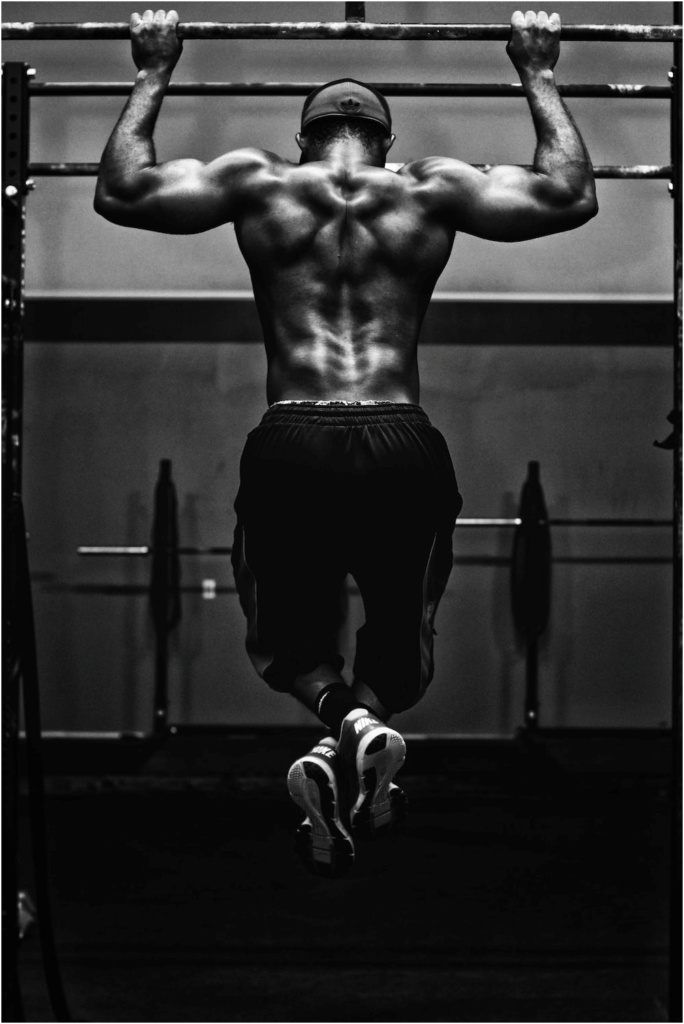Are you ready to take your CrossFit skills to the next level? If you’ve been eyeing those impressive bar muscle ups and wondering how to conquer them, you’ve come to the right place. In this comprehensive guide, we’ll break down the essentials of the bar muscle up for beginners in the world of CrossFit. From prerequisites to technique, drills, and strength-building exercises, we’ll equip you with the knowledge and tools you need to master this challenging movement.
Prerequisites for Bar Muscle Ups.
Before diving into the intricacies of the bar muscle up, it’s important to ensure you possess the necessary strength and skills to approach this movement safely. While the bar muscle up may seem intimidating, there are a few prerequisites you should meet before attempting it.

1. Strict Pull-ups.
To develop the required pulling strength for bar muscle ups, it’s recommended to be able to perform at least 5 unbroken strict pull-ups. Aim for 6 or more for optimal readiness.
2. Kipping Chest to Bar Pull-ups.
The kipping chest to bar pull-up is another essential skill that will contribute to your success in performing bar muscle ups. Aim for at least 4 or more unbroken kipping chest to bar pull-ups.
3. Toes to Bar.
Surprisingly, toes to bar proficiency is a major prerequisite for bar muscle ups. Aim for 5 or more unbroken toes to bar repetitions, with 6 or more being even better.
If you can check off these three prerequisites, you’re ready to delve into the breakdown of the bar muscle up for beginners.
Breaking Down the Bar Muscle Up.
To fully understand the mechanics of the bar muscle up, let’s break down the movement step by step. Each phase of the bar muscle up requires specific body positioning and activation of different muscle groups.
1. Hollow Body.
When approaching the bar, begin with a shoulder-width grip and activate your core and lats to achieve a hollow body position. Imagine pulling down on the bar with straight arms, similar to a kipping toes to bar movement. This will generate the necessary momentum to get above the bar.
Pro Tip: Jumping into the hang position while maintaining a hollow body can provide additional momentum for the bar muscle up.
2. Arch.
From the hollow body position, transition into an arched position under the bar. Ensure that tension is maintained throughout your upper body, resembling the shape of a bow. Avoid bending your knees, as this can lead to a loss of tension.
3. Up & Away.
From the arched position, initiate a swift movement to travel back under the bar and return to the hollow position with increased momentum. Keep your legs extended and activate your lats to lever yourself back and up above the bar. During this step, your shoulders should be moving both up and away from the bar, creating the necessary space for the subsequent flip.
Pro Tip: Maintaining a slight bend in your knees and hips during the levering back motion is crucial for a smooth transition into the next phase.

4. Pop & Pull.
The hip pop is a pivotal moment in the bar muscle up, as it forces your hips into full extension. To achieve this, squeeze your glutes tightly, which will facilitate the necessary upward momentum. As your hips pop, initiate the pull motion, resembling a bar row toward your belly button. The timing and coordination of the hip pop and pull are crucial for success.
Pro Tip: The hip pop generates upward momentum, while the pull directs that momentum over the bar. Ensure that both components are executed with precision.
5. Fast Sit-up.
While pulling yourself up, imagine transitioning into a rapid sit-up motion. The pop and pull should happen with a slight overlap, without any pause in between. Think of throwing off an imaginary hat or breaking through a sheet of glass above the bar. This aggressive transition is necessary to complete the movement successfully.
Pro Tip: Visualize the sit-up motion as a quick and explosive movement, allowing for a seamless transition from the pull to achieving height above the bar.
6. Lock Out.
Once you’ve cleared the bar, take a moment to settle in the dip position and find your balance. This pause is particularly important for beginners to ensure a stable position before completing the movement. After regaining composure, press out to lock out your arms and solidify your bar muscle up.
Pro Tip: Don’t rush the transition and sacrifice proper form. Take the time to stabilize yourself before proceeding further.
Grip Technique and Importance.
A proper grip technique is crucial for executing the bar muscle up effectively. It may seem like a minor detail, but it can significantly impact your performance. Finding the right balance between grip tightness and flexibility is key.
Start by wrapping your hands as far around the bar as possible, with your knuckles above the bar. This grip is similar to a “false grip” on rings, but slightly lower. As you improve your efficiency, you can gradually move away from an aggressive false grip.
Pro Tip: Allow your hands to slide around the bar during the movement, especially after the pop and pull phase. This will prevent you from getting stuck in the transition.

Bar Muscle Up Drills for Beginners.
To enhance your bar muscle up skills, incorporating specific drills into your training routine is essential. These drills will help you develop the necessary strength, form, and muscle memory required for successful bar muscle ups. Let’s explore two effective drills for beginners.
1. Jumping Bar Muscle Ups.
This drill utilizes a box to assist in achieving the movement pattern of a bar muscle up. Choose a box height that positions you at forehead level or lower when standing on it. The higher the box, the easier the drill will be, and vice versa.
- Stand on the box with a shoulder-width grip on the bar.
- Mimic a hollow body position without fully hanging from the bar.
Pro Tip: The jumping bar muscle up drill allows you to practice the movement pattern without relying solely on your pulling strength.
2. Banded Bar Muscle Ups.
Banded bar muscle ups provide assistance through the use of resistance bands. This drill helps beginners work on form correction and reinforces proper movement mechanics.
- Select a band that provides the desired level of assistance based on your strengths and weaknesses.
- Wrap the band around a pull-up bar with enough clearance to perform a kipping bar muscle up.
- Place one foot inside the band and wrap the other foot on top to secure it.
- Position yourself in the starting hang position and initiate the kip for a bar muscle up.
Pro Tip: Banded bar muscle ups are an excellent tool to improve form and address any specific issues such as the “chicken wing” technique.
Building Strength for Bar Muscle Ups.
To enhance your bar muscle up potential, incorporating strength-building exercises into your training regimen is essential. These exercises target specific muscle groups and improve overall strength and stability. Here are some recommended drills to include in your routine:
1. Hollow & Arch Rocks.
To develop the necessary strength for the bar muscle up, practice hollow and arch positions from the floor. Lie on your back with your hands above your head and legs slightly off the ground, maintaining a slight “c” shape. Hold the hollow position for a few seconds, rest, and repeat. For the arch hold, roll over onto your stomach and extend your arms and legs off the ground, resembling a superman pose.
Pro Tip: Hollow and arch rocks are effective for developing the required core and upper body strength for the bar muscle up.
2. Single Leg Glute Bridge.
Strong glutes play a crucial role in the final “hip pop” phase of the bar muscle up. Performing single-leg glute bridges helps strengthen these muscles.
- Lie on your back with your feet flat on the floor, positioned for a bridge.
- Lift one leg and hug it to your chest while pushing through the opposite glute to raise your hips into a bridge.
- Repeat on the other leg.
Pro Tip: Incorporating single-leg glute bridges into your routine improves hip strength and contributes to a powerful hip pop during the bar muscle up.
3. Hollow Body Band Pull-downs.
This exercise targets lat strength and mimics the straight arm engagement required for a bar muscle up.
- Wrap a resistance band around a rig, allowing enough slack to pull the band to the floor.
- Lie on your back in a hollow body position, holding the band with straight arms in front of you.
- Pull the band down towards your body while maintaining the hollow position.
Pro Tip: Hollow body band pull-downs are an effective way to develop lat strength and reinforce the straight arm engagement crucial for bar muscle ups.

What's Next?
Now that you have a solid understanding of the prerequisites, technique, drills, and strength-building exercises for bar muscle ups, it’s time to put your knowledge into practice. Consistency, patience, and a dedicated training regimen will help you progress towards mastering this challenging movement.
Remember to always prioritize safety and proper form during your training sessions. If you need further guidance and want to explore additional resources, check out our free BMU mini-course for beginners.
Keep pushing your boundaries, and soon enough, you’ll be conquering the bar muscle up with confidence and grace. Good luck on your CrossFit journey!
Additional Information:
- Make sure to use the key phrase “muscle up crossfit” throughout your text, including in the title and first paragraph, to optimize for SEO.
- Sprinkle the secondary keywords “crossfit” and “muscle up” naturally throughout the article to enhance keyword relevance.
- Add relevant links, images, and tables to supplement the information and enhance reader engagement.
- Use appropriate markdown formatting, including headings, subheadings, blockquotes, and lists, to improve readability and organization.


